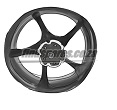Bikes / Tires - Wheels
Advertising
Motorcycle tires
Motorcycle tires provide the contact with the ground or pavement. The tires have a great impact on performance of a motorcycle. Motorcycle tires are available for many different applications including: touring sport, cruiser, scooter, off road, dual sport enduro sport, motocross, racing, and more.
Sport tires provide amazing grip but their endurance is limited and the filling can wear at about 1600 kilometers or less. Modern manufacturers of tires for motorcycles try to find the best compromise between grip and durability of the tire.
There are also tires specifically designed for racing. These tires offer the highest levels of grip when cornering. Due to the high temperature at which these tires typically operate, they are not safe to drive on streets with more normal speed limit for the given conditions because tires usually can not reach optimum temperature required for better traction.
In racing situations, tires are usually heated to the required optimum temperature. There are several properties of motorcycle tires that affect the operation and stability of the motorcycle. Rolling resistance is the resistance when the tire rolls on a flat surface. The rolling resistance of most motorcycle tires is around 0.02.
Cornering power is the lateral force generated during a turn. The power of the motorcycle tire ratio tends to decrease with increases in vertical load, which increases tire pressure and raises their temperature. Convex thrust force is perpendicular to the direction of rolling.
Pneumatic trail is a similar effect produced when motorcycle tires roll on a hard surface. This is the measure of the resulting power steering in side-slip that occurs behind the geometric center of the contact surface. Relaxing long term describes the delay between the slip angle when cornering force reaches its steady-state value.











